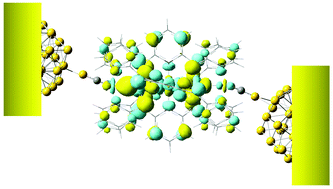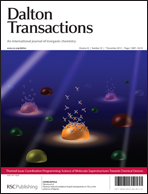Theoretical studies of electronic structures, magnetic properties and electron conductivities of one-dimensional Nin (n = 3, 5, 7) complexes†
Abstract
Electronic structures, magnetic properties and electron conductivities of linearly aligned one-dimensional (1-D) Ni(II)3, Ni(II)5 and Ni(II)7 complexes, i.e. [Ni3(dpa)4NCS2], [Ni5(tpda)4X2] (X = Cl, CN, N3, NCS) and [Ni7(teptra)4Cl2], are systematically investigated by the broken-symmetry B3LYP calculations and simulations based on an elastic scattering Green's function theory. Calculated spin densities appear only at terminal Ni ions, while inner Ni ions are the closed-shell. The calculated effective exchange integrals (Jab) values reproduce well the experimental results that indicate anti-ferromagnetic (AF) interactions between two terminal Ni ions. Natural orbitals and their occupation numbers show that a change in the weak AF couplings by axial ligands in penta-nickel complexes originates in σ-type orbitals. Simulated electron conductivities of [Ni3(dpa)4NCS2] and [Ni5(tpda)4NCS2] semi-quantitatively correspond to the experimental results. By the analyses, it is elucidated that electrons are mainly transmitted by σ-type orbitals, but the bonds between Au and axial ligands are also dominant factors for conductivity.

- This article is part of the themed collection: Coordination Programming: Science of Molecular Superstructures Towards Chemical Devices

 Please wait while we load your content...
Please wait while we load your content...